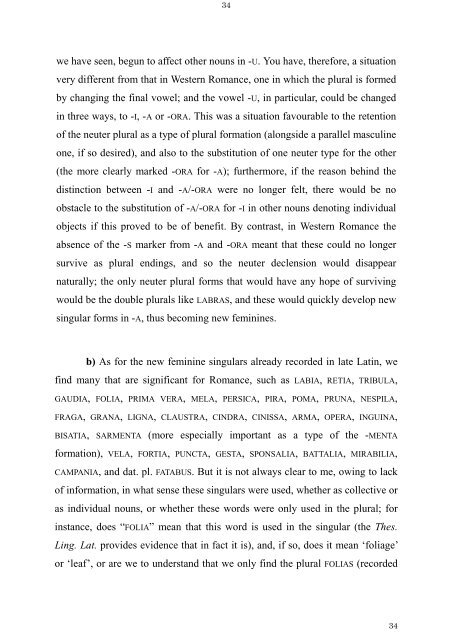The Latin Neuter Plurals in Romance - Page ON
The Latin Neuter Plurals in Romance - Page ON
The Latin Neuter Plurals in Romance - Page ON
Create successful ePaper yourself
Turn your PDF publications into a flip-book with our unique Google optimized e-Paper software.
34<br />
we have seen, begun to affect other nouns <strong>in</strong> -U. You have, therefore, a situation<br />
very different from that <strong>in</strong> Western <strong>Romance</strong>, one <strong>in</strong> which the plural is formed<br />
by chang<strong>in</strong>g the f<strong>in</strong>al vowel; and the vowel -U, <strong>in</strong> particular, could be changed<br />
<strong>in</strong> three ways, to -I, -A or -ORA. This was a situation favourable to the retention<br />
of the neuter plural as a type of plural formation (alongside a parallel mascul<strong>in</strong>e<br />
one, if so desired), and also to the substitution of one neuter type for the other<br />
(the more clearly marked -ORA for -A); furthermore, if the reason beh<strong>in</strong>d the<br />
dist<strong>in</strong>ction between -I and -A/-ORA were no longer felt, there would be no<br />
obstacle to the substitution of -A/-ORA for -I <strong>in</strong> other nouns denot<strong>in</strong>g <strong>in</strong>dividual<br />
objects if this proved to be of benefit. By contrast, <strong>in</strong> Western <strong>Romance</strong> the<br />
absence of the -S marker from -A and -ORA meant that these could no longer<br />
survive as plural end<strong>in</strong>gs, and so the neuter declension would disappear<br />
naturally; the only neuter plural forms that would have any hope of surviv<strong>in</strong>g<br />
would be the double plurals like LABRAS, and these would quickly develop new<br />
s<strong>in</strong>gular forms <strong>in</strong> -A, thus becom<strong>in</strong>g new fem<strong>in</strong><strong>in</strong>es.<br />
b) As for the new fem<strong>in</strong><strong>in</strong>e s<strong>in</strong>gulars already recorded <strong>in</strong> late <strong>Lat<strong>in</strong></strong>, we<br />
f<strong>in</strong>d many that are significant for <strong>Romance</strong>, such as LABIA, RETIA, TRIBULA,<br />
GAUDIA, FOLIA, PRIMA VERA, MELA, PERSICA, PIRA, POMA, PRUNA, NESPILA,<br />
FRAGA, GRANA, LIGNA, CLAUSTRA, CINDRA, CINISSA, ARMA, OPERA, INGUINA,<br />
BISATIA, SARMENTA (more especially important as a type of the -MENTA<br />
formation), VELA, FORTIA, PUNCTA, GESTA, SP<strong>ON</strong>SALIA, BATTALIA, MIRABILIA,<br />
CAMPANIA, and dat. pl. FATABUS. But it is not always clear to me, ow<strong>in</strong>g to lack<br />
of <strong>in</strong>formation, <strong>in</strong> what sense these s<strong>in</strong>gulars were used, whether as collective or<br />
as <strong>in</strong>dividual nouns, or whether these words were only used <strong>in</strong> the plural; for<br />
<strong>in</strong>stance, does “FOLIA” mean that this word is used <strong>in</strong> the s<strong>in</strong>gular (the <strong>The</strong>s.<br />
L<strong>in</strong>g. Lat. provides evidence that <strong>in</strong> fact it is), and, if so, does it mean ‘foliage’<br />
or ‘leaf’, or are we to understand that we only f<strong>in</strong>d the plural FOLIAS (recorded<br />
34









